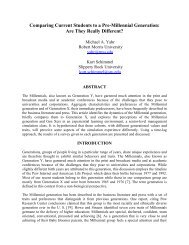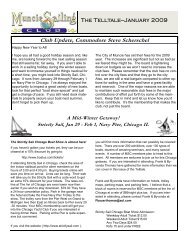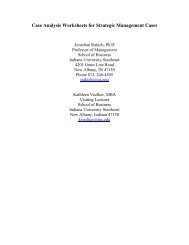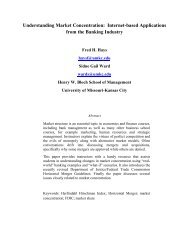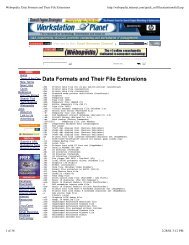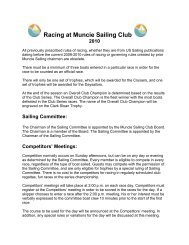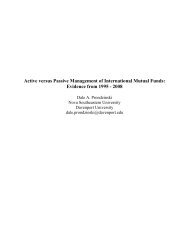Factors Hindering Export Development in Africa: Empirical Evidence ...
Factors Hindering Export Development in Africa: Empirical Evidence ...
Factors Hindering Export Development in Africa: Empirical Evidence ...
Create successful ePaper yourself
Turn your PDF publications into a flip-book with our unique Google optimized e-Paper software.
HYPOTHESESH1: <strong>Export</strong> knowledge barriers with<strong>in</strong> a firm will affect its ability to enter the export market.H2. Internal resources constra<strong>in</strong>ts with<strong>in</strong> a firm will affect its ability to enter the export market.H3. Procedural barriers with<strong>in</strong> a firm will affect its ability to enter the export market.H4: Exogenous barriers with<strong>in</strong> a firm will affect its ability to enter the export market.METHODOLOGYSampleA questionnaire survey was used to elicit responses from small and medium-sized enterprises(SMEs) <strong>in</strong> Nigeria. The data for this study was collected <strong>in</strong> the spr<strong>in</strong>g of 2007. The sample wascomposed of firms listed <strong>in</strong> the Manufacturers Association of Nigeria (MAN) export promotiongroup directory. From this directory we selected five <strong>in</strong>dustrial sectors which met ourpredeterm<strong>in</strong>ed criteria: (1) meet the def<strong>in</strong>ition of a small and medium enterprise def<strong>in</strong>ed by(Storey, 1994) as employ<strong>in</strong>g between 10 and 500 employees,(2) manufacture or export thefollow<strong>in</strong>g products, food and beverages, textile and cloth<strong>in</strong>g, plastics and chemical, and leatherand shoes, (3) locate <strong>in</strong> <strong>in</strong>dustrial and manufactur<strong>in</strong>g cities of Aba, Kano, Lagos, and PortHarcourt, and (4) have a m<strong>in</strong>imum annual turnover of six million naira about ($50, 000). Arandom selection of 140 firms from the list was successfully contacted through a letter and faxrequest<strong>in</strong>g their participation <strong>in</strong> the research. The firms identified from the list were personallyvisited or contacted by telephone for permission to participate <strong>in</strong> the study. To avoid loss anddelay due to the weaknesses <strong>in</strong> the communication and postal system <strong>in</strong> Nigeria a drop-off andpick-up method was adopted. This method ensured distribution and collection procedures, whichwere systematic and controlled by the lead <strong>in</strong>vestigator. Eight tra<strong>in</strong>ed research assistants werehired and charged with the responsibility of distribution and collection of the surveyquestionnaires. A total of 96 usable surveys were received, which provided a response rate of69%. Of the 96 firms, 42 or (44%) are export<strong>in</strong>g firms and 54 or (56%) are non-export<strong>in</strong>g firms.SURVEY INSTRUMENT<strong>Export</strong> barriersThe export barrier was measured by the questionnaires developed by [24] and [23]. In thequestionnaire the respondent was asked to <strong>in</strong>dicate to what extent he/she considered that variousdifferent export barriers acted as obstacles to the <strong>in</strong>itiation or expansion of his/her firm’s exportactivity. Five-po<strong>in</strong>t Likert scales were used for this purpose, with responses rang<strong>in</strong>g from ‘not anobstacle’ to ‘major obstacle’. <strong>Export</strong> barriers was measured by the follow<strong>in</strong>g criteria: (1) lack ofknowledge of best potential markets; (2) lack of f<strong>in</strong>ances for market research; (3) lack of staff forexport plann<strong>in</strong>g; (4) effect of strong foreign competition; (5) general lack of knowledge of howto export, (6) lack of transportation and shipp<strong>in</strong>g costs, (7) language and cultural barriers, (8)Corruption, ( (9) poor <strong>in</strong>frastructure, (10) differences <strong>in</strong> exchange rates, and (11) bureaucraticbottlenecks or red tapes. In addition, respondents were asked to rank order what obstacle theyconsider to be the most important export barriers. Table 1 shows that lack of market knowledgewas ranked as the most important barrier, with a (mean of 4.60) followed by lack of exportf<strong>in</strong>ance with a mean of (4.55) and the least important barrier was poor <strong>in</strong>frastructure with a mean



